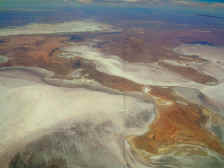 Flying from Melbourne to get to Ayers Rock all the flights go to Sydney then out to Ayres Rock. The flight from Sydney to Ayers Rock is just under three hours. Below the plane Central Australia tells a story of ages when giant seas covered the central portion of Australia.
Flying from Melbourne to get to Ayers Rock all the flights go to Sydney then out to Ayres Rock. The flight from Sydney to Ayers Rock is just under three hours. Below the plane Central Australia tells a story of ages when giant seas covered the central portion of Australia.
 A wasteland of harsh climates where the temperature reaches 45 degree celsius most days (107 Fahrenheit). The indenginous people of Australia, known as aboriginals, found a way to live in harmony with the harsh lands around them. Aboriginals would find the artisian wells below the desert and grubs, guana, bugs, beetles, and roots to sustain themselves.
A wasteland of harsh climates where the temperature reaches 45 degree celsius most days (107 Fahrenheit). The indenginous people of Australia, known as aboriginals, found a way to live in harmony with the harsh lands around them. Aboriginals would find the artisian wells below the desert and grubs, guana, bugs, beetles, and roots to sustain themselves.
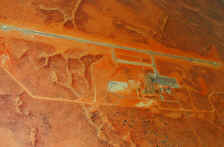 Pictured is the new airport at Ayers Rock. An old airport, run by a gentleman named Connellan, ran flights in and out of Ayers Rock since 1959. See story below.
Pictured is the new airport at Ayers Rock. An old airport, run by a gentleman named Connellan, ran flights in and out of Ayers Rock since 1959. See story below.
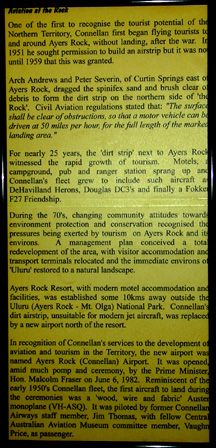
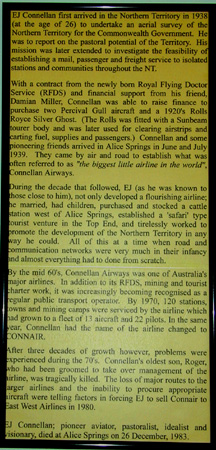
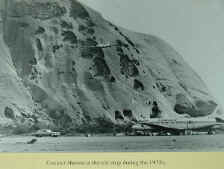
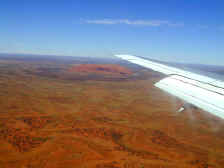 Our first view of Ayers Rock from the plane. What is really is a shock is that Ayers Rock is just that; a giant rock. As hard as granite and one solid piece of rock sticking out of the ground for millions of years. As I understand "Uluru", the rock, was created when the ocean was in central Australia. Billions of years of sedimentary deposits high in iron settled hardened. Mountains pushed
Our first view of Ayers Rock from the plane. What is really is a shock is that Ayers Rock is just that; a giant rock. As hard as granite and one solid piece of rock sticking out of the ground for millions of years. As I understand "Uluru", the rock, was created when the ocean was in central Australia. Billions of years of sedimentary deposits high in iron settled hardened. Mountains pushed  up, wore away, and the basin was turned on its side and was covered again during the ice age then left again. This solid hard rock teems with life. About twice a year it rains in the desert. At the summit, 1,400 feet above, small water basins exist after heavy rains. These dry up within 20-30 days. In this time period triops and a small fish, not more than 3mm in length, have an entire life cycle. Ian found them ( of course)! The eggs of the animals have to survive dried up for sometimes years to be re-activated when washed into these small water catches. No one else seemed to know there were fish on Ayers Rock. None of the books we looked at mentioned them. We may have discovered a new species of fish. If so we'll have to call them Cooke fish.
up, wore away, and the basin was turned on its side and was covered again during the ice age then left again. This solid hard rock teems with life. About twice a year it rains in the desert. At the summit, 1,400 feet above, small water basins exist after heavy rains. These dry up within 20-30 days. In this time period triops and a small fish, not more than 3mm in length, have an entire life cycle. Ian found them ( of course)! The eggs of the animals have to survive dried up for sometimes years to be re-activated when washed into these small water catches. No one else seemed to know there were fish on Ayers Rock. None of the books we looked at mentioned them. We may have discovered a new species of fish. If so we'll have to call them Cooke fish.
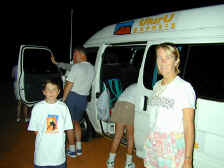 We get up at 4am to make the half hour van ride to the "Rock" to watch sunrise before the climb. Some coffee and what seemed as though it would take forever finally came about with with the temperature rising from a mere 70 degrees to 105.
We get up at 4am to make the half hour van ride to the "Rock" to watch sunrise before the climb. Some coffee and what seemed as though it would take forever finally came about with with the temperature rising from a mere 70 degrees to 105.
 Sunrise in the desert. The moon shines down over the desert with Jupiter bright in the sky below not wishing to be to be forgotten.
Sunrise in the desert. The moon shines down over the desert with Jupiter bright in the sky below not wishing to be to be forgotten.
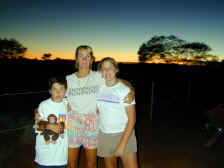 Pam and the kids getting ready for the climb; happy the sun did come up in anticipation of the long day ahead of us.
Pam and the kids getting ready for the climb; happy the sun did come up in anticipation of the long day ahead of us.